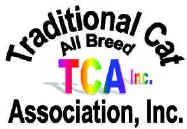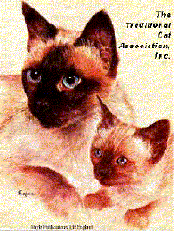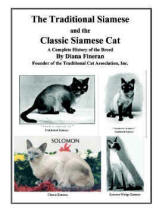|
HISTORY OF THE TRADITIONAL DEVON REX© CAT
Copyright: Diana Fineran May 2006
Breeders List
It was in 1959 when the un-named father of the Traditional
Devon Rex breed was living in a derelict tin mine near Buckfastleigh in Devon,
England. This wild tom, with a wild and wavy coat, consorted with another wild,
tortie and white female. The resulting litter was born in a field near a garden
owned by Miss Beryl Cox of Devonshire England, who lived not far from the mine.
She was a kind lady, who had been crippled as a result of a war injury, so she
gave shelter to the mother cat and kittens behind her house. One of the kittens
was exceptional. It was a brownish-black male, Miss Cox named Kirlee because he
had lots of curls, some even cascaded in ringlets on his tail. He was a mirror
image of his father. All his litter mates had straight coats, so he was a real
stand out.
Since the Rex gene is recessive and must be present in both
parents before its effects can be seen in their kittens, it is assumed that the
Tortie and White mother was a straight coated offspring of the wild, unnamed tin
mine male. Her litter was considered to be sired by her own sire.
As a cat lover, Beryl Cox delighted in Kirlee’s unique
appearance, his warmth and intelligence, his ability to walk a tight rope and
the charming way he wagged his tail when ever he was praised for his
achievement. Still, she had no inclination to create an entire curly coated
breed.
She heard about Brian Sterling-Webb’s cats. The story goes
that he had owned a curly haired male named Kallibunker, who is the father of
the Classic Cornish Rex breed. Kallibunker was born in Cornwall, the next county
east of Devon 10 years before Kirlee’s birth. Sterling-Web was using two of
Kallibunker’s sons and his mother in an effort to establish a curly haired
breed. It was discovered by out crossing to straight coated cats that the gene
responsible for the “rexed” coat mutation was a simple recessive. The first
litters were all straight coated kittens. When those kittens were breed back to
Kallibunker the results were 50% curly and 50% straight. Ten years after
Kallibunkers’ birth an article was published in the British Newspaper, The
English Daily Mirror, featuring a photo of a curly cat with one eye closed,
appearing to be winking. He was pronounced to be the only curly coated kitten
in the country. This kitten was Du-Bu Lambtex, the first curly coated kitten to
be born as a result of the defined breeding efforts with Kallibunker. Seeing the
article, Miss Cox wrote a letter to the breeders, telling them that Lambtex
wasn’t the only curly coated kitten in the country. She said she had Kirlee.
Brian Sterling-Webb and Mrs. Agness Watts of Du-Bu Cattery decided some one
should go to see this kitten to confirm if he was another genetic curly coated
mutation. It was Agness Watts and her daughter, Susan, who went to the
neighboring count to see Kirlee. Indeed, they found him to be a lovely curly
coated cat. They encouraged Miss Cox to allow Kirlee to be used in the budding
breeding program. So it was that Miss Cox sold her beloved Kirlee to Brian
Sterling-Webb for 25 English pounds. Kirlee left his home county of Devon, then
and took residence with Agnes and Susan Watts at Darby House. There were
several breedings between Kirlee and Classic Cornish Rex, both purebred and
straight coated hybrids, which produced only normal coated kittens. The
conclusion was clear. The Classic Cornish Rex and the Traditional Devon Rex
were separate breeds caused by an entirely different gene type. The Classic
Cornish Rex were called Gene I Rex and the Traditional Devon Rex became known as
Gene II Rex.
From then on Kirlee and his descendants were known as the
Devon Rex, and were developed as a separate breed.
Mrs. P. Hughes was a member of the breeders doing the
original experiments. She kept one of the straight coated females, a
descendant of Kallibunker, from a litter she bred, named Broughton Golden Rain,
who was bred back to her sire, Kirlee. The litter produced had two straight
coated kittens and on curly, blue cream female. This kitten was the first curly
coated kitten to be produced by Kirlee. Broughton Golden Rain was later bred to
a Gene I (Classic Cornish Rex) and produced a litter of two straight coated
kittens and two curly kittens. She became the first known hybrid to carry both
Rex genes.
Kirlee was neutered in 1964 and placed in a loving pet home
by Mr. Stirling-Webb. Kirlee lived out a long and happy life, even continued to
preside at cat shows until 1970 as the greatly admired original Traditional
Devon Rex. Sadly Kirlee passed away in 1970 due to injuries suffered in a street
accident.
Of coarse, there are differences in the physical structure
of the two breeds, but in addition there is a great difference in their coat
textures. The Traditional Devon Rex has all three types of hairs; guard, awn
and down. Their guard hair is very sparse, short and curly. Their fur is
denser, causing the more open, billowing wave and looser curl of the Traditional
Devon Rex. The Classic Cornish Rex lacks guard hairs.
The original breeders of the Traditional Devon Rex managed
to expand the limited gene pool in order to pass on Kirlee’s mutated genes to
his kittens as simple recessive genes. Out crossing was done to British
Shorthairs, American Shorthairs, Burmese, Bombays and Siamese. Eventually the
physical appearance was standardized as we see it today. It is often referred to
as a pixie like look. Reflecting the breed’s diverse beginnings, every possible
color and pattern is accepted.
One of those who took up the banner to breed these
wonderful cats in Britain was Alison Ashford, of Annelida Cattery. She
recounted the purchase of her first: “I visited Mrs. Sedgefield of Esher one day
in 1962 and saw Du-Bu-Debbie, a young tortoiseshell female, with her litter of
Rex and plain kittens. One kitten jumped into my arms from the floor, and
literally refused to be put down. I tried to turn away, but loud purring and a
wagging tail were prelude to another amorous leap. This was Broughm, then six
months old. I could not then really afford the price of a Tex kitten, but I
could not leave him. So I rashly wrote a cheque on my housekeeping account and
phoned home to warn my husband to have a bed ready for the new acquisition. I
was given a some what cold reception, when I arrived home, but Broughm’s charm
soon convinced the family that it would be worth eating bread and cheese for the
next month. “(Ashford and Pond, p. 18)
The Traditional Devon Rex was accepted for competition in
Europe (GCCF) in 1967. Gentry’s Amharic Kurly Katie, bred by Mrs. Knight,
became the first Traditional Devon Rex Champion in any association.
The Traditional Devon Rex to cross the Atlantic was
Annelida Smokey Pearl, who was purchased by Miss Mary Carroll in Canada.
Annelida Callidor joined Pearl, but no known breedings occurred between the two.
The first Traditional Devon Rex breeding program in the
U.S. began in 1968, when Marion White and her daughter Anita brought two cats
with them to the U.S. after a military posting in England. Alison Ashford chose
Annelida Aubretia and Wigmel Black Witch for the two Americans. At their new
home in Austin, Texas, they produced Anglo-Tex Devon Rex .
Adding to the breed in the U.S. in 1969 Shirley Lambert of
Bob-N Shir Cattery imported Hesperian Orchid and Wigmel Telaman to her cattery
in Texas. These two were Seal Pointed and were the first pointed Traditional
Devon Rex in the U.S. A few more cats were imported by the Whites and the
Lamberts. They worked together with a combined number of eight cats. Among
those imported were Annellida Sunset Gleam of Anglo-Tex, Redcliffe Pegasus of
Bob ‘N Shir, Hadrian Blue Angel of Anglo-Tex, and Toby Touchstone of Van Dol.
In 1974 Becky Curneen, of Far North Cattery, imported two
to Washington State. Delores Johnson, of Dee Jon Cattery, imported three to
Oregon. Frank and Wendy Chappell, of Yclept Cattery, imported five to British
Columbia. Frances Kirkham, of Cal-Van Cattery, imported two to Alberta.
In 1977, Ann Gibney of Scattergold Cattery came back from
England with her first named, Annelida Pervinca, and she bought a second in
1980.
In 1978 British breeders Roma and Lajla Lund of Homeacres
Cattery, immigrated to the U.S. bringing with them over a dozen of their cats
with them.
In 1980, Mary Robinson, of Marya Cattery fell in love with
pictures of a New Zealand cat named Annelida Seagull. Subsequently she tracked
down their breeder and imported three from New Zealand to Canada.
The danger of inbreeding, frowned upon by TCA, INC. raised
it’s inevitable dark side, when genetic problems were manifested. Genetic
problems present in the general cat bloodlines were concentrated in the
Traditional Devon Rex due to the intense inbreeding. In addition, a
neurological condition causing muscle spasticity appeared only in the Devons. A
second problem was parental blood incompatibilities causing the death of
kittens. Many Traditional Devon Rex were found to carry Type A blood, while
others carried Type B blood. An A male bred to a B female caused the mother’s
milk to contain antibodies against the kittens’ own blood, resulting the death
of the kittens. Blood typing is now done to avoid this horror. If such a bad
breeding happens, the kittens are hand fed every two hours until the gut closes
internally and they can handle the antibodies on their own. To reverse the
damage done, total out crossing was the focus.
The coat of a Traditional Devon Rex is so fascinating.
Waves are only part of the whole. Their unique coat appears to be missing the
hard, outer coat known as guard hairs. These hairs have been reduced to twisted
little stubs that are buried deep in the cat’s undercoat. The remaining coat is
fine, finer than a piece of thread. Unlike a Classic Cornish Rex coat, the
Traditional Devon’s coat doesn’t wave, but rather whirls in every direction or
curls tightly in neat rows of fur. It is also described as soft, suede like and
full bodied. The feel of the coat isn’t wooly. Instead it feels close to
crushed velvet. They are wonderful to snuggle with because their lack of outer
coat makes them feel warmer to the touch than most regular coated cats.
They are very much a wash and wear cat with only an
occasional cleaning of their ears, nail clipping, a short shampoo and towel dry,
or even a wipe down with a damp cloth is all the grooming needed.
PERSONALITY OF THE TRADITIONAL DEVON REX
©
Copyright: Diana Fineran May 2006
The Traditional Devon Rex is very people oriented. They
have been referred to as “poodle” cats because it is said they have much in
common with their poodle dog counterparts. They want your complete and
undivided attention during most of their waking hours, as they are strongly
devoted to their people. They’re not happy just sitting in your lap. You need
to be actively caressing them. They aren’t the kind of cat that comes around
only at feeding time. As heat seeker, some may be found lounging on computer
monitors, near heater vents and on television sets.
They are easy going, highly active, fun loving, playful,
mischievous, captivating, and face each new adventure with a true love of life.
Wanting to be involved with everything, and always close to their people, little
escapes their interest or investigation. As an outgoing breed, they purr
incessantly. It is usual for them to run to meet you when you arrive home at
the end of the day to tell you all about their day and how much you were
missed. At about three weeks of age they begin to be driven to be with people.
As hearty eaters, they do tend to beg for table food just because you are there
and they desire your attention.
At night they will find a favorite spot to snuggle with you
in bed. Some prefer to sleep under the covers, while others would rather caress
your head and hair. Perhaps they can be compared to the heated bricks inn
keepers use to provide for their guest’s beds.
An added benefit is that they don’t shed fur in blizzard
like amounts as some breeds do.
Sociable, intelligent, friendly, inquisitive and possessing
an exceptional temperament, the Traditional Devon Rex appeals to a variety of
cat lovers. Some say they are addictive just like popcorn. Many owners find it
hard to set them down or stop at just one.
HEALTH OF THE TRADITIONAL DEVON REX ©
Copyright: Diana Fineran May 2006
During the development of the Traditional Devon Rex from
one curly coated male, Kirlee, many other breeds were used as out crosses.
British Shorthairs, American Shorthairs, Burmese, Bombays and Siamese were used
to further the breed and insure that Kirlee’s characteristics were passed on to
his kittens as a simple recessive gene.
This wide range of bloodlines ensures a healthy gene pool
for future cats.
Along the way intense inbreeding was done repeatedly and
the dark side of this practice raised its ugly head. Genetic problems common in
the general cat population became concentrated in the Traditional Devon Rex.
Also a neurological condition causing muscle spasticity appeared only in Devons.
Secondly a parental blood incompatibility resulted in the death of kittens.
Many were found to carry Type A blood, when other carried Type B blood. When an
A male was bred to a B female, the mother’s milk would contain antibodies
against the kittens’ own blood, causing the death of kittens. Breeding Devons
are now blood typed. If a bad breeding occurs, the kittens are hand fed every
two hours until the gut closes internally and they can handle the antibodies on
their own. Out crossing to other breeds became the focus to save the breed.
These are just some of the reasons why TCA, INC. does not
support or condone intense inbreeding.
The focus now is on out crossing to repair the damage done
to the breed.
|

 The
Traditional Cat Association,
Inc.©1987®TM
Official Website
The
Traditional Cat Association,
Inc.©1987®TM
Official Website